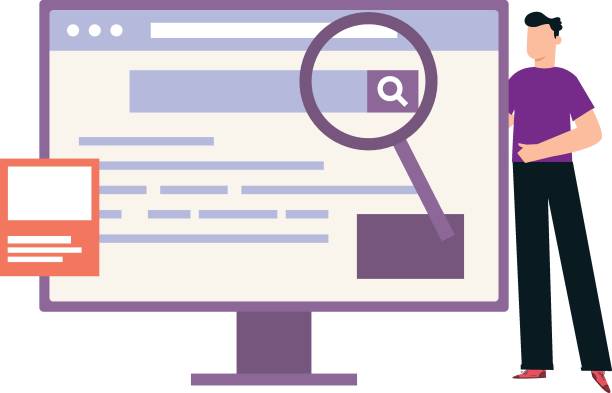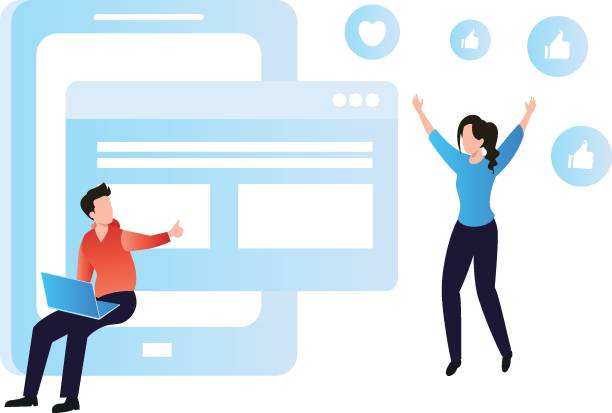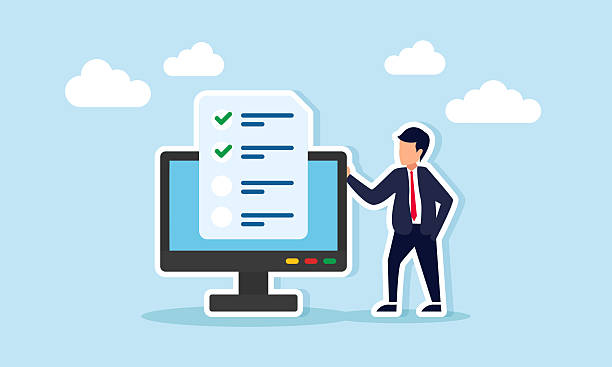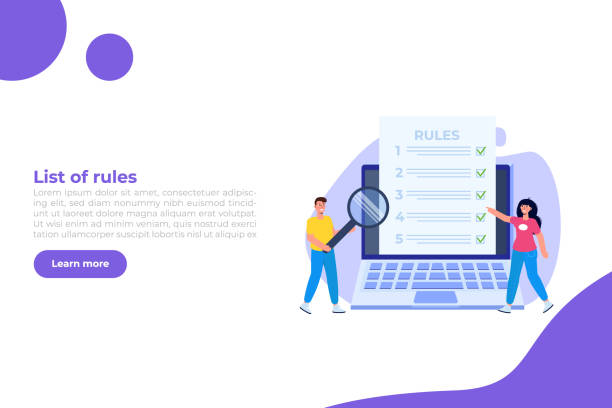Introduction to Multilingual Website Design and Its Necessity

In today’s world, where geographical boundaries mean less and businesses seek to expand their activities internationally, having a website only in Persian is no longer sufficient.
#Multilingual website design is an essential necessity for companies that dream of reaching global markets and attracting diverse audiences.
This approach not only increases your website’s accessibility but also allows you to communicate more effectively with users from different cultures and languages.
The main goal of #multilingual website design is to remove language barriers that can prevent users from fully interacting with your content.
Suppose a German-speaking user is looking for a specific product; if your website is only in English or Persian, there is a very high probability that they will leave your page and go to a competitor who offers services in their native language.
Therefore, investing in a multilingual platform is not just a luxury choice but a vital strategy for sustainable growth and development in the global arena.
This is an educational content that explains the foundation of the topic and is essential for understanding subsequent concepts.
Is your company’s website as professional and trustworthy as it should be? With specialized corporate website design by Rasaweb, create an online presence that reflects your credibility and attracts more customers.
✅ Build a powerful and professional image for your brand
✅ Convert visitors into real customers
⚡ Get a free consultation now!
Advantages of Having a Multilingual Website for Businesses

The benefits of multilingual website design go beyond mere communication; it can directly impact your business’s growth and profitability.
The first and most important advantage is a significant increase in audience reach.
By supporting different languages, you can access millions of new users worldwide who were previously out of reach due to language barriers.
This expanded audience leads to increased website traffic and, ultimately, sales growth.
Second, it leads to improved international SEO.
Search engines prefer multilingual websites for display in local search results, which means higher rankings and greater visibility.
Third, it strengthens credibility and branding.
A website offered in multiple languages demonstrates your professionalism and global approach, attracting the trust of international customers.
Fourth, it reduces bounce rates and increases user engagement.
Users prefer to interact with content in their own language, which leads to increased time spent on the site and reduced exit rates.
This section is explanatory and analytical, discussing the tangible benefits of this type of design.
Key Stages in Planning Multilingual Website Design

Careful planning is the backbone of a successful multilingual website design.
This stage involves important strategic decisions that affect the final outcome of the project.
The first step is identifying target languages.
Market research should be conducted to determine which languages have the most potential for your business.
This selection should be based on current customer demographics, future target markets, and website traffic data (if available).
The next step is choosing the appropriate URL structure, such as subdomains (en.example.com), subdirectories (example.com/en), or country-code top-level domains (example.de).
Each of these structures has its own advantages and disadvantages in terms of SEO and management.
Also, selecting a platform and Content Management System (CMS) that fully supports multilingualism is crucial.
WordPress with plugins like WPML, Drupal, and Joomla are examples of popular CMSs for this purpose.
Finally, planning for the translation and localization process is of paramount importance.
This includes deciding whether to use human translators, machine translation (with human editing), and paying attention to cultural differences (localization).
This section is of a guidance and specialized nature.
| URL Structure | Advantages | Disadvantages | Example |
|---|---|---|---|
| Subdirectory | Easier management, stronger SEO for the main domain | Requires a stronger server, may appear less local to some engines | example.com/en/ |
| Subdomain | Easier content separation, stronger local SEO | Requires separate management for each subdomain | en.example.com |
| Top-level domain (ccTLD) | Excellent local SEO, greater user trust | Higher cost, more complex management, requires purchasing multiple domains | example.de |
Suitable Technologies and Platforms for Multilingualization

Choosing the right technology and platform is one of the most important decisions in multilingual website design.
The Content Management System (CMS) you choose should have strong built-in multilingual capabilities or provide this functionality through plugins and modules.
WordPress, with popular plugins like WPML (WordPress Multilingual Plugin) or Polylang, is a common option that allows for easy management of translations and multilingual content.
Drupal and Joomla are also powerful CMSs that were designed from the outset for complex and multilingual sites, offering high flexibility.
For larger and custom projects, frameworks like Laravel in PHP or Django in Python allow developers to create fully customized multilingual systems.
Platform selection should be based on specific project needs, budget, required scalability, and the development team’s capabilities.
It is important that the chosen platform correctly supports UTF-8 for various language characters and allows for the creation of SEO-friendly URLs in different languages.
This section is specialized and explanatory, addressing the technical tools required.
Are you worried that your company’s old website might scare away new customers? Rasaweb solves this problem with modern and efficient corporate website design.
✅ Increases your brand’s credibility.
✅ Helps attract targeted customers.
⚡ Contact Rasaweb for a free consultation!
International SEO and Search Engine Optimization

Simply having a multilingual website design is not enough; you must ensure that this site is visible to search engines like Google in local target markets.
International SEO is a set of techniques that help search engines understand the language and target region of your pages.
One of the most important tools for this is the use of the hreflang tag.
This tag tells search engines which languages a specific page supports and for which geographical regions it is targeted.
For example, if you have content in English for users in the USA and other content in English for users in the UK, hreflang helps Google show the correct version to the appropriate user.
Keyword research for each language and region is also crucial, as keywords may have different meanings in different languages or there may be specific local searches.
Site loading speed, mobile responsiveness, and content quality also play important roles in international SEO.
Optimizing the sitemap and registering the site in Google Webmaster Tools for each language version is also recommended.
This content is primarily analytical and specialized, covering the technical aspects of SEO.
Content Management and Quality Translation

The quality of translation and content management is the backbone of a successful multilingual website design.
Translation is not merely replacing words; it involves content localization.
Localization means adapting content to the culture, customs, units of measurement, dates, and even the tone and communication style of the target audience in each region.
Using native-speaking translators who specialize in your business domain is highly recommended, as they can accurately convey cultural nuances and specific terminology.
Machine translation, while faster and cheaper, typically lacks the necessary accuracy and quality for sensitive or marketing content and requires extensive human editing.
A Translation Management System (TMS) can help integrate the translation process, maintain consistency in vocabulary and terminology, and manage the translation workflow.
Furthermore, maintaining content consistency across all language versions, while they are localized, is important.
A comprehensive content strategy that includes a content calendar for updates and new translations helps maintain the site’s effectiveness and appeal.
This section includes specialized and guidance tips for content management.
Common Challenges and Solutions in Implementing Multilingual Design

Implementing a multilingual website design, although offering countless benefits, also comes with challenges that need to be anticipated and addressed.
One of the biggest challenges is managing translation and maintenance costs.
High-quality translation into numerous languages can be very expensive.
The solution is to first focus on languages with the highest ROI potential and then gradually add other languages.
Utilizing Translation Memories (TM) and specialized glossaries can also help reduce costs and increase consistency.
Another challenge is technical and SEO issues; for example, ensuring the correct functioning of hreflang tags, loading speed for users in different parts of the world, and managing multilingual URLs.
For these, collaboration with international SEO specialists and experienced developers is essential.
The third challenge is maintaining User Experience (UX) consistency across all languages and cultures.
This includes ensuring that the design, navigation, and forms are displayed correctly in different languages and are aligned with users’ cultural expectations.
Thorough testing (QA) in all languages and review by native-speaking users can resolve this issue.
This section is analytical and thought-provoking content (in terms of raising challenges).
| Challenge | Explanation | Suggested Solution |
|---|---|---|
| Translation and Maintenance Costs | High cost of quality translation and continuous updates | Focus on key languages, use of TM and TMS, detailed budgeting |
| International SEO | Correct ranking in local search engines | Correct use of hreflang tags, local keyword research, site speed optimization |
| Cultural Localization | Content mismatch with local culture and expectations | Use of native translators, testing by local users, attention to cultural UX |
| Content Management | Complexity of updating and syncing content in different languages | Use of a strong CMS with multilingual capabilities, organized translation workflow |
User Experience (UX) in Multilingual Websites

A multilingual website design is not limited to text translation; it must provide a seamless and optimized User Experience (UX) for all users, regardless of their language.
The first point in multilingual UX is easy and clear language selection functionality. Language change options should be easily accessible and visible, usually in the site’s header or footer.
Using country flags to indicate languages can be misleading; it is better to use the language name (e.g., “English”, “Français”).
The design should be visually flexible for different languages that may have different word lengths (e.g., German compared to English) or are written from right to left (like Persian and Arabic).
This includes fonts, layout, and text direction (RTL/LTR).
Ensuring that forms, dates, currencies, and units of measurement are correctly localized for the target region is also vital.
The ultimate goal is to create a sense of familiarity and comfort for the user in every language, enabling them to easily interact with the site and achieve their purpose.
This section is educational and guidance-oriented, focusing on the human aspects of design.
Are you worried about losing customers because you don’t have a professional e-commerce website?
With e-commerce website design by Rasaweb, forget these worries!
✅ Significant increase in sales and visitor-to-customer conversion rates
✅ Professional and user-friendly design that builds customer trust
⚡ Get a free consultation from Rasaweb
Maintenance and Updates of a Multilingual Website

After launch, maintaining and updating a multilingual website design is just as important as its initial design.
Content on the web is constantly changing and being updated, and these updates must be applied to all language versions.
A comprehensive content strategy should include a regular plan for translating and publishing new content and updates to existing content.
This includes blog articles, product pages, FAQ sections, and any other content that may change.
Monitoring site performance in all languages through web analytics tools like Google Analytics is also essential.
This helps you identify potential issues with loading, navigation, or conversion rates in each language.
Furthermore, you should have a defined process for handling user feedback in different languages.
Technical issues such as updating plugins or the CMS, regular backups, and security monitoring must also be performed across all language versions to ensure the site’s stability and proper functioning.
This section is a comprehensive guide for post-launch management.
The Future of Multilingual Website Design and New Trends

The future of multilingual website design is strongly tied to technological advancements, especially in the fields of artificial intelligence and machine translation.
Machine translation tools are expected to continuously become more accurate and natural, which could make the initial translation process faster and more cost-effective.
However, the role of localization and human translators will remain vital, as cultural nuances and specific terminology still require human understanding.
Another emerging trend is content personalization based on the user’s language and region.
This means displaying dynamic content and different product suggestions based on the user’s geographical location and preferred language, elevating the user experience to a higher level.
Furthermore, the increased use of voice search and smart assistants highlights the need to optimize content for these types of searches in various languages.
Multilingual websites are moving towards more immersive and interactive experiences where content is not merely translated but completely reimagined for each cultural and linguistic market.
This is a news and entertaining perspective on the future.
Frequently Asked Questions
| Question | Answer |
|---|---|
| What is a multilingual website? | It is a website whose content is available to users in several different languages. |
| Why should we design a multilingual website? | To expand access to international audiences, increase site traffic, improve SEO in target markets, and provide a better user experience for non-Persian speaking users. |
| What are the main methods of implementing a multilingual website? | Using subdomains (e.g., en.mysite.com), using subdirectories (e.g., mysite.com/en/), and using separate domains for each language (e.g., mysite.com and mysite.de). |
| Which implementation method is better for SEO? | Generally, using subdirectories (language folders) is often recommended due to the transfer of the main domain’s authority to other languages. |
| What is the Hreflang tag and what is its use? | It is an HTML tag or HTTP Header that tells search engines which version of the page is suitable for which language or geographical region. This tag prevents duplicate content and improves SEO. |
| How is a Language Switcher designed? | Typically using a dropdown menu, button, or flag in the site’s header or footer, which allows the user to select their preferred language. |
| Is automatic (machine) translation suitable for a multilingual website? | No, machine translation usually has low quality and many errors that can harm the site’s credibility. Human translation or a combination of human translation and machine editing is recommended. |
| What are the most important SEO tips in multilingual website design? | Correct use of the Hreflang tag, having an appropriate URL structure for each language, translating titles and meta descriptions, translating core content, internal linking between related language versions. |
| Should all website content be translated? | It depends on the strategy. Typically, the main and important content of the site should be translated. Less important sections or blogs may not require full translation. |
| What are the main challenges in multilingual website design? | Managing content in different languages, translation costs, technical issues related to URLs and language tags, template compatibility with right-to-left (RTL) languages like Persian and Arabic, and multilingual SEO management. |
And other advertising services from Rasa Web Advertising Agency:
Smart Data Analysis: A fast and efficient solution for improving SEO ranking with a focus on intelligent data analysis.
Smart Link Building: An effective tool for increasing sales through attractive UI design.
Smart Link Building: Designed for businesses seeking online growth through precise audience targeting.
Smart Content Strategy: A combination of creativity and technology to increase click-through rates with an SEO-focused content strategy.
Smart Google Ads: A creative platform to improve sales growth with an attractive UI design.
And over a hundred other services in the field of online advertising, advertising consulting, and organizational solutions.
Online Advertising | Advertising Strategy | Advertorials
Resources
Multilingual Website Design
Advantages of Global Online Presence
Multilingual Site SEO
Comprehensive Web Design Guide
? Are you ready for your business to leap forward in the digital world? Rasaweb Afarin Digital Marketing Agency, specializing in SEO, content marketing, and responsive website design, is with you to reach the peak.
📍 Tehran, Mirdamad Street, next to Bank Markazi, Kazeroon Jonubi Alley, Ramin Alley, No. 6


